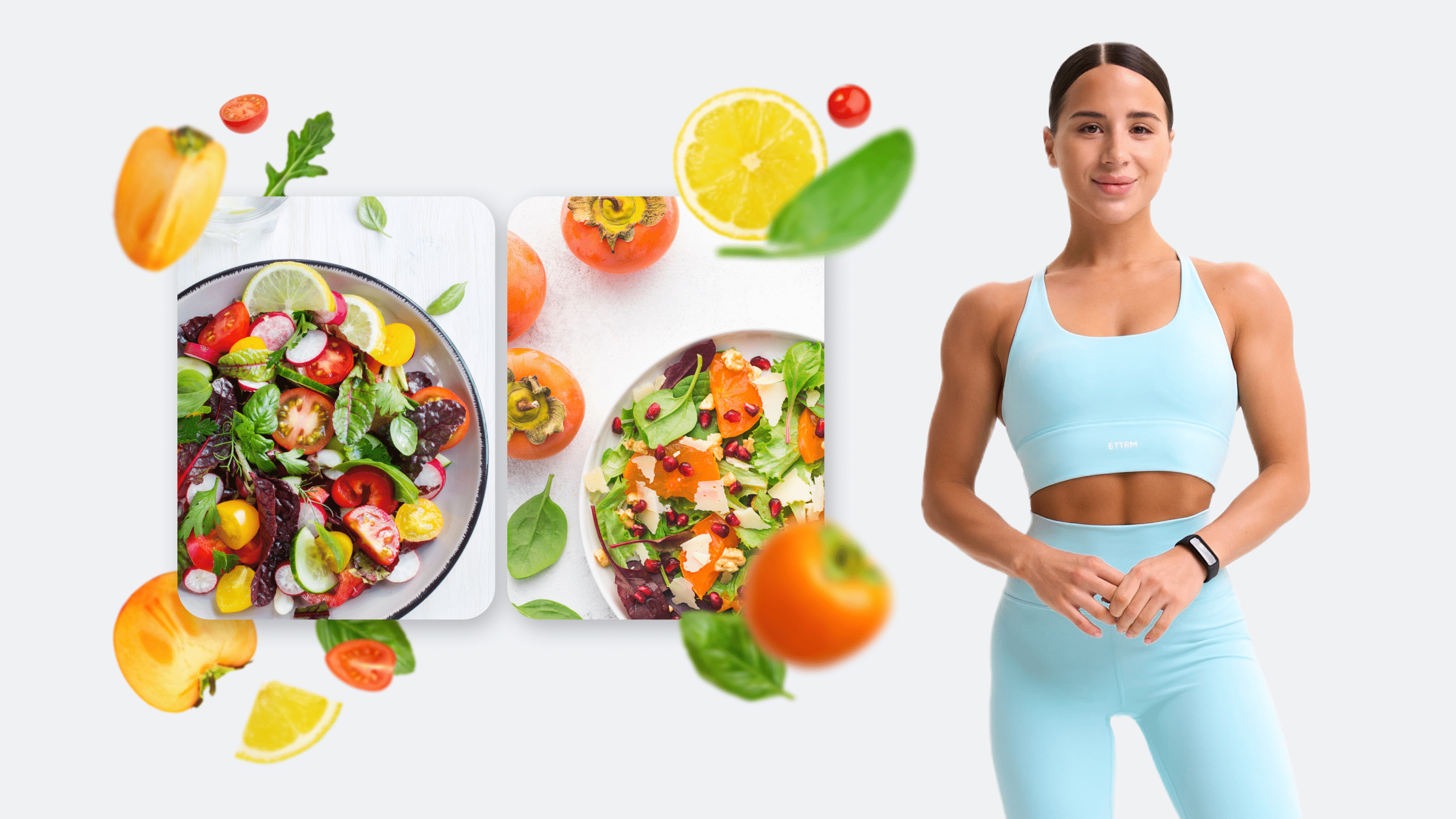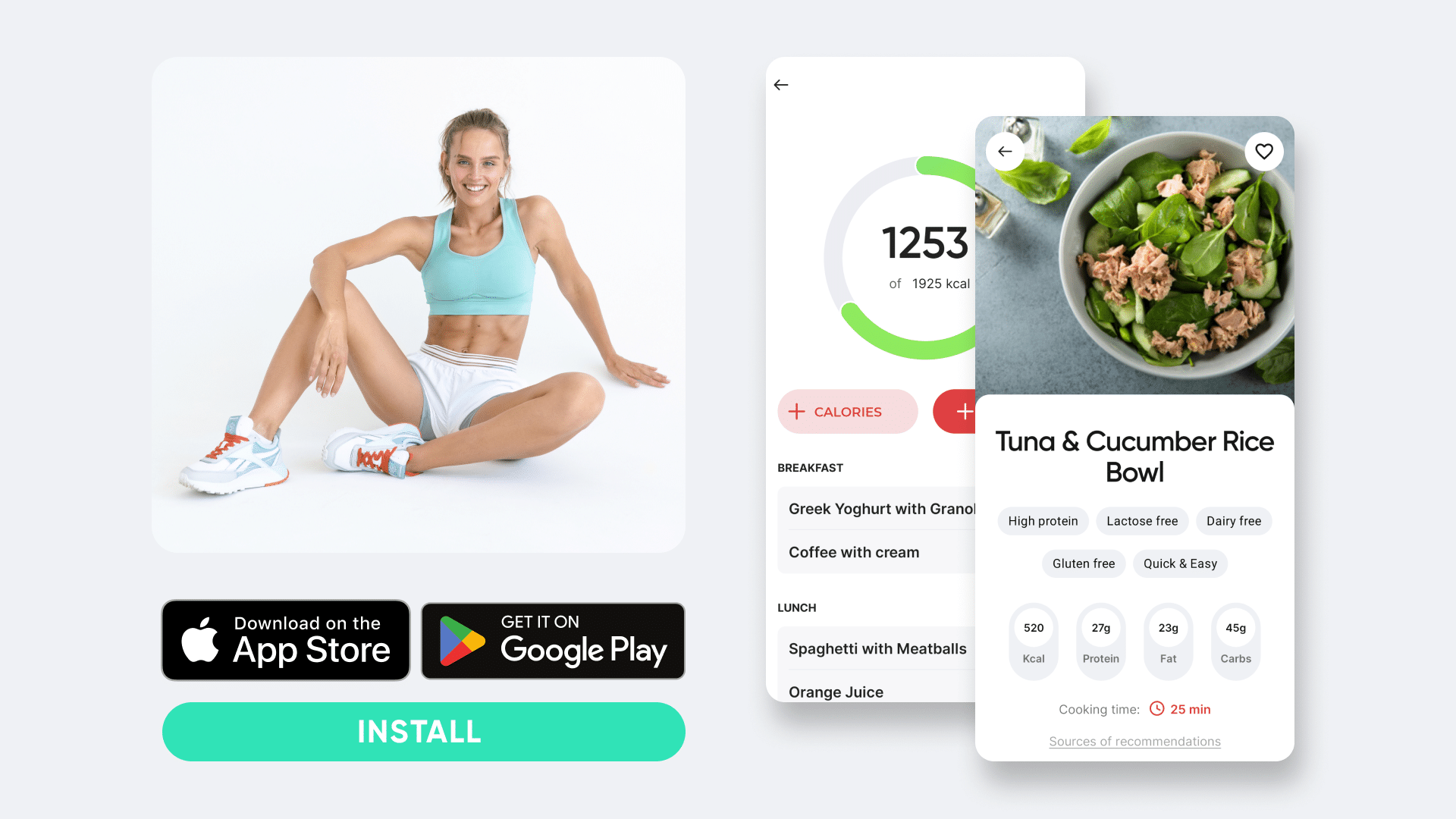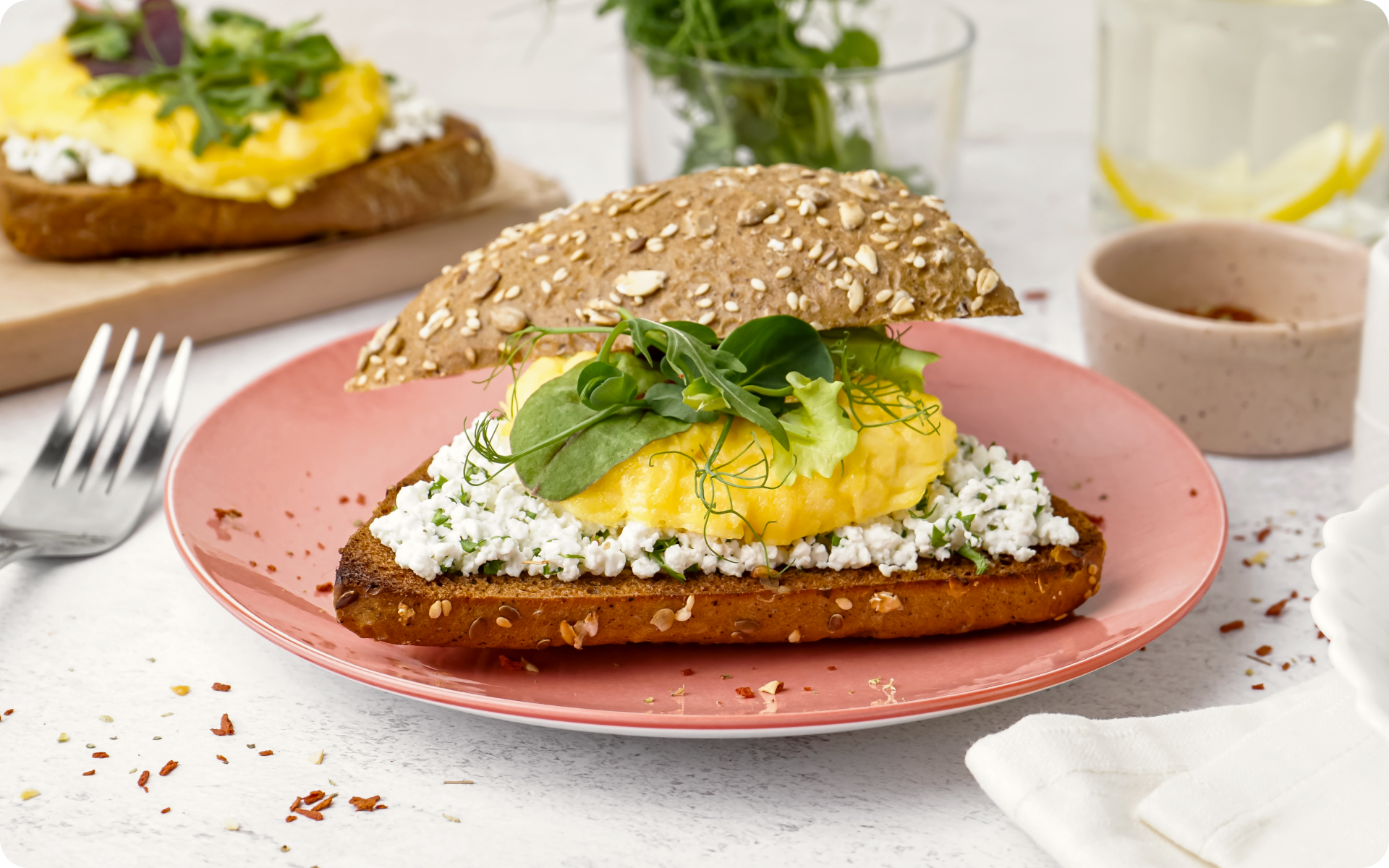You’ve seen dozens of diet and workout plans, each with its own unique aspects and all promising that you’ll lose weight. The truth is, all these weight loss tactics have one thing in common – they all aim to create a calorie deficit.
The difference between different diets is how easy or difficult they are to stick to for long-term weight loss. You could create a calorie deficit by completely avoiding food on a water fast or by moderately reducing how much you eat over time. Both methods will work, but a water fast is much harder to sustain and may not work for long-term weight loss.
To identify the best 30-day diet plan for weight loss, you need to understand how to create a sustainable calorie deficit. You also need to understand safe weight loss – how many kilos should you be cutting each week? Here’s your 30-day weight loss cheat sheet.
How Can I Slim Down in 30 Days? Creating a Calorie Deficit Through Diet and Exercise
A calorie deficit is a difference between how many calories you consume and how many calories your body burns. You can create a calorie deficit by eating less, exercising more, or doing both (32).
You must understand that weight loss accelerates when you create a large enough calorie deficit. For example, if two people each have 2,000 calories to spend every day, but one person eats 1,900 calories while the other eats just 1,500 calories, they’ll lose weight at different rates even though both are making good food choices and exercise regularly.
This is why 30-day weight-loss diets that include exercise can work so effectively. You’re burning additional calories and creating a bigger deficit through a combination of diet and exercise. This changes the equation from simply “eat less than your body needs” to “burn more than what you eat”.
Yanking yourself back in shape has never been so easy with our game-changing fitness app! Start transforming your life with BetterMe!
How Much Weight Can You Lose in 30 Days?
There’s a wide range of options for weight loss in 30 days. For example, you may lose as little as 0.5kg per week or up to 3kg per week – this is the extreme end of quick weight loss diets, but some people have lost more than 10 kilos on no-exercise diet plans. However, rapid weight loss is not generally sustainable. The slower you lose the weight, the more likely you are to keep it off.
Several factors determine how much weight you will lose and how fast you’ll lose it, including:
Current Weight
Your current weight partially determines your metabolic rate, i.e. how many calories you burn per day. The more you weigh, the more calories you’ll burn just to stay alive (14). For example, person A who weighs 136 kgs and burns 2,800 calories per day, can cut more daily calories to lose weight faster than person B, who weighs 68 kgs and burns 1,800 calories per day.
Person A may be able to cut 1,000 or more calories to create a deficit, while Person B can cut a maximum of 600 calories. It’s not recommended to cut daily calories below 1,200, and some experts argue that even 1,200 is too little for most people.
In addition, as you lose weight, your metabolism adjusts to your new energy requirements, which are lower than they were before. This means that you may see quicker results initially, but your progress will slow down as you get leaner.
Lifestyle
If you’re already living a healthy lifestyle, the scale is going to move much more slowly. However, if you’re ditching an unhealthy lifestyle and starting from scratch, you’ll probably see faster results. Going from poor nutrition, zero activity, poor sleep, and high stress levels to a brand new healthy lifestyle means you’re likely to see significant changes sooner.
Genetics
Genetics is a major factor in your ability to lose weight (13). Some people simply drop weight more easily than others. For example, if you have lots of fast-twitch muscle fibers and a naturally high metabolism, it’s going to be easier for you to stick with the exercise plan, meaning that you may see quicker results.
Sleep Habits
Getting high-quality sleep impacts how fast you lose weight. Getting a good night’s sleep makes you feel energized and ready to make healthy changes. It also helps curb your appetite and cravings, which keeps your calorie intake in check during the day. Finally, poor sleep quality can affect your metabolism and slow down your progress.
Age
Age is a fairly big factor in how fast you lose weight. The older you are, the harder it will be to burn fat. If you’re young, your metabolism will speed up and slow down at regular intervals. This means that during periods of growth (e.g. puberty), your body will naturally increase your metabolic rate to help you grow (1).
However, as you get older, your metabolism naturally slows down, in part due to a process called sarcopenia, i.e. loss of muscle mass. As muscle is a large contributor to your daily metabolic rate, losing it will slow down your fat-burning mechanisms (23).
In addition, hormonal changes that come with age make it harder to lose weight. Some hormonal changes that may affect your metabolism include the reduction of testosterone in men and the reduced production of thyroid hormones, in addition to changes associated with menopause in women (19).
Choice of Workout
Aerobic exercise (e.g. running, cycling) is the quickest way to lose weight as it helps you burn more calories. It also plays an important role in heart health (12). However, it doesn’t build muscle, and when muscle levels decline, your metabolism may be affected negatively. This can make it more difficult for you to see results in the future.
Including strength training remedies this by increasing or at least maintaining your muscle mass (15). It’s important to note that a proper strength training routine may seem to slow down your weight loss progress as a given volume of muscle weighs more than the same volume of fat. Therefore, you may appear leaner while weighing the same.
You should try to include both aerobic exercise and strength training into your weekly routine.
Read more: 24 Weight Loss Smoothies, 2 Diet Plans, and 5 Belly Fat Smoothie Secrets
What Is a Safe Rate of Weight Loss?
Some people expect quick results from the 30-day diet meal plan for weight loss. It’s important to note that rapid weight loss can increase your risk of gallstones, dehydration, and malnutrition (21).
According to the National Institutes of Health, safe weight loss is approximately 1–2 pounds (0.45–1 kg) per week (10).
You should also keep in mind that weight loss is not a linear process. Some weeks you may lose more, while other weeks, you may lose less or none at all (31).
What Are the Best Foods for Weight Loss?
Before creating a 30-day diet plan for weight loss, you must understand that it’s not just about the specific foods you eat, but how they fit together to create a nutritious, balanced diet. You need to choose a variety of nutrient-dense foods from all food groups, and put together meals where approximately half of your plate consists of fruits and vegetables, a quarter is lean protein, and the final quarter is a complex carbohydrate.
Here are some examples of foods to include in your balanced weight-loss diet:
Low-Calorie Foods
Foods that are low in calories but rich in nutrients and fiber can help you feel satisfied and full after you’ve eaten, while still creating a calorie deficit. Try to fill half your plate at each meal with low-calorie fruits and non-starchy vegetables.
Examples of low-calorie foods to include in your weight-loss diet include:
- Lychees
- Papayas
- Grapefruits
- Berries
- Apples
- Celery
- Cucumber
- Romaine lettuce
- Tomatoes
- Carrots
- White mushrooms
- Cauliflower
- Broccoli
High-Protein Foods
Protein plays a significant role in weight loss (22). A protein-packed diet promotes a greater metabolic rate by providing the building blocks for building muscle and also helps you feel fuller for longer, which prevents snacking and cravings.
The best way to get more protein is to eat lean proteins. You should limit or avoid processed meats, as they’re higher in fat and sodium and may contribute to the risk of colon cancer.
Examples of high-protein foods include:
- Eggs
- Lean beef
- Chicken breast (without skin)
- Turkey breast (no skin)
- Pork tenderloin
- Fish such as tilapia, salmon (fresh or canned), sardines, and tuna
- Soy products such as tofu, tempeh, and edamame
- Low-fat dairy products such as Greek yogurt and cottage cheese
- Eggs
- Whey protein powders
- Soy or pea protein powder
- Nut butter
Fiber-Rich Foods
Fiber-rich foods are digested slowly by your body. As a result, they keep you feeling full for longer and make it easier to eat less. They also help promote digestive health by encouraging regularity and supporting a healthy gut microbiome. Most experts recommend eating 25-38 grams of fiber each day if you’re looking to lose weight (28).
When creating a diet plan for weight loss, you should include foods with plenty of fiber such as:
- Vegetables such as broccoli, cabbage, kale, spinach, sweet potatoes, onions, and celery
- Whole grains such as brown rice, quinoa, oatmeal, and whole wheat pasta and bread
- Legumes such as lentils, beans (kidney beans, black beans), and peas
- Fruits such as apples, bananas, pears, peaches, and berries (raspberries, blueberries)
If you wish to cinch your waist, tone up your bat wings, blast away the muffin top – our fitness app was created to cater to all your needs! BetterMe won’t give excess weight a chance!
Fat-Burning Foods
When you’re trying to achieve a calorie deficit and lose weight fast, foods that are believed to help burn fat or have related health benefits may be your allies.
Here are the top foods, herbs, and spices to include in your 30-day diet plan for weight loss:
- Green Tea
Green tea is full of antioxidants called catechins. These antioxidants may increase metabolic rate while the small amount of caffeine may help increase energy and focus (27).
- Thyme
This herb has phenolic compounds that may have antioxidant, anti-inflammatory, and antimicrobial activity, in addition to beneficial effects on cardiovascular disease risk factors (3).
- Oregano
Oregano contains carvacrol, a powerful compound that may help boost weight loss. One study of mice on a high-fat diet that either contained carvacrol or not found those that received carvacrol gained significantly less body weight and body fat than the control group (6). Although this doesn’t directly translate to humans, including oregano in your spice cabinet can contribute flavor without added sodium or calories.
- Chili Peppers
Cayenne pepper is one popular variety of chili that has been suggested to have several fat-burning properties. It contains capsaicin, a compound that has been shown to boost metabolism, reduce levels of the hunger-stimulating hormone Ghrelin, and promote feelings of fullness (8).
- Garlic
Garlic is believed to be a natural appetite suppressant. One study found that garlic supplementation resulted in a decrease in waist circumference (26). Use garlic as an ingredient in your meals for tasty results without added calories or sodium.
- Ginger
In addition to speeding up digestion, ginger and its active compounds such as gingerol have been suggested to have anti-obesity effects (4).
- Cinnamon
Cinnamon has been linked with lower fasting blood sugar and triglyceride levels in people with type 2 diabetes (9).
Nutrient-Dense Foods
Most people don’t get enough of the nutrients that are found in whole foods. By following a diet that’s rich in nutrient-dense foods, you may have better health and be more satisfied with less food (7). Foods that are nutrient-rich also tend to be lower in calories. Examples of nutrient-dense foods include:
- Vegetables such as broccoli, cabbage, kale, spinach, sweet potatoes, onions, and celery
- Whole grains such as brown rice, quinoa, and oatmeal
- Legumes such as lentils, beans (kidney beans, black beans), and peas
- Fruits such as apples, bananas, pears, peaches, and berries (raspberries, blueberries)
- Lean meats and fish
- Low-fat dairy
When creating your weight loss meal plan for the next 30 days, make sure to include plenty of these foods in every meal. You’ll feel more energized and satisfied throughout the day, and you won’t have to worry about micronutrient deficiencies.
If you’re new to cooking or don’t like the taste of certain whole foods, there are many ways you can make them more enjoyable. You can add spices that improve their flavors, such as cayenne pepper, oregano, thyme, cinnamon, and ginger. You can also add fresh herbs for a change in flavor, such as parsley, dill, mint, and basil.
Healthy Fats
Fat is an underrated source of energy and a building block for hormone production. It helps protect cells while also helping keep you satiated throughout the day. For example, omega-3 fatty acids have been linked with reduced obesity in rodents(18).
In addition, fats are a must-have in a vegan diet for weight loss 30-day plan as some nutrients that are found in fruits and vegetables cannot be absorbed by your body in the absence of fats.
Healthy fats can be found in:
- Nuts and seeds such as almonds, walnuts, cashews, flaxseeds, chia seeds, and sunflower seeds
- Fatty fish such as salmon, tuna, and trout
- Plant sources such as olives or olive oil, avocados or avocado oil, and other vegetable oils
Complex Carbohydrates
Complex carbohydrates tend to be lower on the glycemic index. This means they don’t cause spikes in blood sugar levels. They’re also more filling than simple carbohydrates as they’re digested slowly (5).
While they may not feature much in a 30-day keto diet plan for weight loss, you can still have them as a primary energy source when you’re following other diet plans.
Examples of complex carbs include:
- Whole grains such as brown rice, quinoa, oatmeal, and whole-grain bread or pasta
- Legumes such as lentils, beans (kidney beans, black beans), and peas
- Starchy vegetables such as potatoes, sweet potatoes, and winter squash
Read more: Your Guide To The 7-Day Protein Diet Plan for Weight Loss
Sample 30-Day Diet Plan for Weight Loss
So, you know what to eat and what to avoid for 30 days to reach your goal. But what does a calorie deficit look like?
Here’s a sample one-day 1,500-calorie meal plan that can help you shed weight:
Day 1
- Breakfast: 1 serving vegetables with 3 egg scramble (33g carbs, 29g fat, 29g protein, 511 calories)
- Lunch: 2 servings cucumber slices with 1 strawberry protein smoothie (27.6g carbs, 11.6g fat, 53.6g protein, 371 calories)
- Supper: 2 servings beef stir fry (58g carbs, 17g fat, 47g protein, 586 calories)
Total daily calories: 1,513 calories
Day 2
- Breakfast: 2 servings spinach and mushroom breakfast scramble with 1 cup strawberries (23.3g carbs, 10.9g fat, 60.3g protein, 430 calories)
- Lunch: 2 servings mango strawberry arugula salad (65g carbs, 23.1g fat, 9.2g protein, 457 calories)
- Supper: 2 servings pasta with red sauce and mozzarella (95.2g carbs, 14.3g fat, 32.3g protein, 617 calories)
Total daily calories: 1,504 calories
Day 3
- Breakfast: 1 serving powerball smoothie (38.1g carbs, 43.9g fat, 5.4g protein, 528 calories)
- Lunch: 2 servings turkey lettuce roll-ups with 2 ounces almonds (17.5g carbs, 30.9g fat, 30.3g protein, 447 calories)
- Supper: 2 chicken wraps (49.2g carbs, 11.6g fat, 47.9g protein, 505 calories)
Total daily calories: 1,480 calories
Day 4
- Breakfast: 1 serving peanut butter and banana oatmeal with 1 medium apple (71.1g carbs, 12.4g fat, 11.1g protein, 402 calories)
- Lunch: 2 servings all American tuna (31.9g carbs, 11.9g fat, 70.6g protein, 512 calories)
- Supper: 2 lavash chicken wraps (31g carbs, 24g fat, 74.2g protein, 584 calories)
Total daily calories: 1,498 calories
Day 5
- Breakfast: 1 bowl knock-oats (63.5g carbs, 19.6g fat, 14g protein, 451 calories)
- Lunch: 16 ounces nonfat Greek yogurt and 2 medium bananas (70.2g carbs, 2.6g fat, 48.7g protein, 478 calories)
- Supper: 1 serving avocado chicken salad (11.6g carbs, 34.4g fat, 55.1g protein, 573 calories)
Total daily calories: 1,502 calories
Day 6
- Breakfast: 1 tropical protein smoothie (76.9g carbs, 2.2g fat, 28.4g protein, 425 calories)
- Lunch: 1 serving salmon wrapped avocado (12g carbs, 40.3g fat, 21.8g protein, 486 calories)
- Supper: 2 servings vegetable and chicken salad (42.2g carbs, 31.4g fat, 38.9g protein, 589 calories)
Total daily calories: 1,500 calories
Day 7
- Breakfast: 1 oatmeal banana protein shake (49g carbs, 17g fat, 54g protein, 546 calories)
- Lunch: 2 servings quick buffalo chicken salad (18g carbs, 18g fat, 57g protein, 456 calories)
- Supper: 1 serving black-bean quesadillas (53.6g carbs, 22.3g fat, 24.2g protein, 500 calories)
Total daily calories: 1,502 calories
FAQs
How can you reduce stomach fat?
To reduce stomach fat, you need to create a calorie deficit over a period of time. This means consuming fewer calories than your body needs, which results in it using stored fat for energy instead. You can achieve this in many ways, but some are more effective than others.
Nutrient-Dense Diet
Diet is the most important factor when it comes to reducing stomach fat. You should focus on consuming whole, nutrient-dense foods that are high in nutrition and relatively low in calories.
Foods such as fruits, vegetables, lean proteins, and healthy fats should make up the majority of your diet. These foods provide essential vitamins and minerals while keeping you full and satisfied.
Unlike ultra-processed foods, these whole foods are not loaded with added sugars, unhealthy fats, and empty calories. Rather than trigger a craving for more food, they provide sustainable energy to your body.
In addition, whole foods are rich in fiber, which helps with digestion and keeps you feeling full for longer.
Portion Control
While eating nutrient-dense foods is essential, it’s also important to monitor your portion sizes (30). Even healthy foods can lead to weight gain if they’re consumed in excess. You should aim for a well-balanced meal consisting of fruits and vegetables, lean protein, complex carbohydrates, and healthy fats in moderate portions.
One way to practice portion control is by using measuring cups or food scales to accurately measure out your food. Another method is to use the plate method, where half of your plate consists of non-starchy vegetables, a quarter consists of lean protein, and a quarter consists of complex carbohydrates.
Regular Exercise
In addition to adopting a nutrient-dense diet and practicing portion control, regular physical activity is essential for reducing stomach fat. It uses up stored fat for energy and helps build lean muscle mass, which boosts metabolism and burns more calories even when you’re at rest (11).
You should aim for a combination of cardiovascular exercise and strength training.
Cardiovascular exercises, such as running, cycling, or swimming, help burn overall body fat. Strength training with weights or resistance bands targets specific muscle groups and helps build lean muscle mass (24). This increases metabolism and helps burn fat more efficiently (16).
Adequate Sleep
Getting enough sleep is often overlooked as an important factor in weight loss. Studies have shown that a lack of sleep can lead to increased levels of the hunger hormone ghrelin and decreased levels of the satiety hormone leptin, which contributes to overeating and weight gain (29).
You should aim for 7-9 hours of quality sleep each night to allow your body to rest and recover. This will also help regulate hormones and reduce cravings for high-calorie foods.
Stress Management
Stress can have a significant impact on weight gain, particularly in the abdominal area. When you’re stressed, your body produces cortisol, a hormone that stimulates fat storage in the belly region (20).
Finding healthy ways to manage stress, such as meditation, yoga, or spending time outdoors, can help reduce cortisol levels and help with weight loss.
Does walking burn belly fat?
Walking increases calorie expenditure, which is essential for reducing overall body fat, including belly fat (2). How briskly and for how long you walk will determine the amount of calories you burn. To burn more belly fat, consider adding hills or intervals to your walking routine.
In addition, regular walking can help maintain a healthy weight and prevent future weight gain. It’s also a low-impact form of exercise that’s accessible to most people and can be incorporated into daily routines easily.
Can you change your body in 30 days?
You can make significant changes to your body in 30 days. The most significant change may be how you feel; your energy levels may increase, and you may experience better sleep and improved mood.
Physically, you may appear less bloated as you’ve increased your consumption of fiber-rich, nutrient-dense foods.
In terms of weight loss, it’s possible to lose 1-2 pounds per week through a combination of a healthy diet and regular exercise. Therefore, you could potentially lose 4-8 pounds in 30 days.
If you maintain these healthy habits beyond 30 days, you will continue to see changes and improvements in your body over time.
How can you burn 1,000 calories a day?
You may be able to burn 1,000 calories a day by creating a significant calorie deficit through a combination of diet and exercise.
Creating a deficit of 500 calories through diet is possible for some people; you can either cut out 500 calories from your diet or choose to eat fewer high-calorie foods. Intermittent fasting is also an option, where you consume all your daily calories within a specific window of time (17).
To burn the remaining 500 calories through exercise, you should consider incorporating high-intensity interval training (HIIT) into your routine. This involves short bursts of intense exercise followed by periods of rest or low-intensity exercise (25). Other options include cycling, running, or swimming for an extended period. Working more movement into your regular daily routine can also help.
A more long-term approach is increasing muscle mass through strength training (24). This can increase your metabolism, which allows you to burn more calories at rest (16).
The Bottom Line
30 days can feel like a lifetime when it comes to forming new habits. However, after the first month, you’ll feel stronger, your energy levels will be higher, and most importantly, you’ll have lost weight. Patience is a great quality to have.
Expecting immediate weight loss can be frustrating as many factors come into play, such as genetics, age, and stress levels. Once you quit stressing over the number on the scale, your patience will help you be more successful in the long term.
DISCLAIMER:
This article is intended for general informational purposes only and does not serve to address individual circumstances. It is not a substitute for professional advice or help and should not be relied on for making any kind of decision-making. Any action taken as a direct or indirect result of the information in this article is entirely at your own risk and is your sole responsibility.
BetterMe, its content staff, and its medical advisors accept no responsibility for inaccuracies, errors, misstatements, inconsistencies, or omissions and specifically disclaim any liability, loss or risk, personal, professional or otherwise, which may be incurred as a consequence, directly or indirectly, of the use and/or application of any content.
You should always seek the advice of your physician or other qualified health provider with any questions you may have regarding a medical condition or your specific situation. Never disregard professional medical advice or delay seeking it because of BetterMe content. If you suspect or think you may have a medical emergency, call your doctor.
SOURCES:
- [Aging, basal metabolic rate, and nutrition] (2019, pubmed.ncbi.nlm.nih.gov)
- 5 surprising benefits of walking – Harvard Health (2023, health.harvard.edu)
- A Review on Applications and Uses of Thymus in the Food Industry (2020, ncbi.nlm.nih.gov)
- Bioactive Compounds and Bioactivities of Ginger (Zingiber officinale Roscoe) (2019,ncbi.nlm.nih.gov)
- Carbohydrates and Blood Sugar | The Nutrition Source | Harvard TH Chan School of Public Health (2010, hsph.harvard.edu)
- Carvacrol prevents diet-induced obesity by modulating gene expressions involved in adipogenesis and inflammation in mice fed with high-fat diet (2012, pubmed.ncbi.nlm.nih.gov)
- Changing perceptions of hunger on a high nutrient density diet – Nutrition Journal (2010, nutritionj.biomedcentral.com)
- Chili pepper as a body weight-loss food (2017, pubmed.ncbi.nlm.nih.gov)
- Cinnamon improves glucose and lipids of people with type 2 diabetes (2003, pubmed.ncbi.nlm.nih.gov)
- Clinical Guidelines On The Identification , Evaluation , And Treatment Of Overweight And Obesity In Adults: The Evidence Report (1998, nhlbi.nih.gov)
- Effect of Exercise Training on Fat Loss—Energetic Perspectives and the Role of Improved Adipose Tissue Function and Body Fat Distribution (2021, frontiersin.org)
- Exercise and Cardiovascular Health | Circulation (2003, ahajournals.org)
- Genetic predictors of weight loss in overweight and obese subjects (2019, ncbi.nlm.nih.gov)
- How can I speed up my metabolism? (2020, nhs.uk)
- Increasing Lean Mass and Strength: A Comparison of High Frequency Strength Training to Lower Frequency Strength Training (2016, ncbi.nlm.nih.gov)
- Increasing muscle mass to improve metabolism (2013, ncbi.nlm.nih.gov)
- Intermittent fasting and weight loss (2020, ncbi.nlm.nih.gov)
- Long-Chain Omega-3 Polyunsaturated Fatty Acids May Be Beneficial for Reducing Obesity—A Review (2010, ncbi.nlm.nih.gov)
- Metabolic adaptation to weight loss: implications for the athlete (2014, ncbi.nlm.nih.gov)
- Obesity and Stress: A Contingent Paralysis (2022, ncbi.nlm.nih.gov)
- Risk of symptomatic gallstones and cholecystectomy after a very-low-calorie diet or low-calorie diet in a commercial weight loss program: 1-year matched cohort study (2014, pubmed.ncbi.nlm.nih.gov)
- role of protein in weight loss and maintenance (2015, academic.oup.com)
- Sarcopenia of aging and its metabolic impact (2005, pubmed.ncbi.nlm.nih.gov)
- Strength training: Get stronger, leaner, healthier – Mayo Clinic (202, mayoclinic.org)
- The Effect of High-Intensity Interval Training Type on Body Fat Percentage, Fat and Fat-Free Mass: A Systematic Review and Meta-Analysis of Randomized Clinical Trials (2023, mdpi.com)
- The effects of garlic supplementation on weight loss: A systematic review and meta-analysis of randomized controlled trials (2021, pubmed.ncbi.nlm.nih.gov)
- The effects of green tea on weight loss and weight maintenance: a meta-analysis (2009, pubmed.ncbi.nlm.nih.gov)
- The Health Benefits of Dietary Fibre (2020, ncbi.nlm.nih.gov)
- The role of insufficient sleep and circadian misalignment in obesity (2022, nature.com)
- Understanding the science of portion control and the art of downsizing (2018, ncbi.nlm.nih.gov)
- Why do obese patients not lose more weight when treated with low-calorie diets? A mechanistic perspective (2007, pubmed.ncbi.nlm.nih.gov)
- “Calories in, calories out” and macronutrient intake: the hope, hype, and science of calories (2017, journals.physiology.org)












